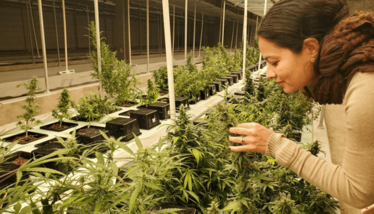Musings from the Power List: Daniela Vergara
Our 2022 Power List finalists share their insights on the cannabis science field. Here, Daniela discusses the biggest challenge facing cannabis science, her predictions for the field, and her advice for anyone following in her footsteps…
| 4 min read | Interview

What has been the biggest breakthrough in cannabis science in the last few years?
My very biased answer? Establishing that there are multiple genes encoding cannabinoids that vary in copy within and between varieties and lineages, that these genes are in close proximity in the genome, and that they are specific to C. sativa. These were like an “explosion” of genes that happened after the speciation event with hops (Humulus spp).
What is the single biggest challenge facing cannabis science in 2022 – and beyond?
Federal legalization. After that happens, it will be who owns the data (intellectual property) for many of the genetic/genomic tools that will be developed. Many of these tools are being developed by private companies that could be bought by big agriculture or big pharma, so I’d rather focus on the positive!
Do you have any predictions for the field over the next few years?
Cannabis will become another agricultural crop like wheat or corn and farmers will have similar relationships with buyers. However, those relationships need to be established and now we are in a chicken-and-egg situation. Farmers don’t want to plant many acres of hemp without a buyer – and buyers don’t buy because there’s no supply. There are also very few processors in the US and that’s the most expensive part of the supply chain, so getting established will be hard – but, again, I’d rather stay positive!
Do you have any strong opinions with which the rest of the field disagrees?
Oh, so many! My main one: it has been shown (in my papers and by multiple others) that the distinctions between sativa, indica, and hybrid strains are all nonsense.
If you weren’t in the cannabis industry, what would you be doing?
I might be a political activist; I’m very loud despite my short stature! Or perhaps I would own a landscaping company. Or maybe I would be a teacher. Or I would be doing stats and graphs for some company. Or I would be writing and editing for a magazine or journal. Or perhaps all of the above!
Who have been your heroes or mentors?
Well, my dad and my mom for sure. My dad was my first teacher (and he’s a physics professor, so there you go). Then my undergrad advisors, Felipe Guhl (with whom I published my most cited paper), Ivan Darío Vélez, and Luz Elena Velazquez; my PhD advisor, Curt Lively, who is the most wonderfully knowledgeable person in the world; my postdoc advisor, Nolan Kane, who is both funny and the kindest person ever; and of course, Reggie Gaudino, who is the savviest cannabist ever. I’ve been fortunate in my mentors.
What advice do you have for those following in your footsteps?
It’s not easy. Get some guts. It’s a total rollercoaster. Take a stance. Avoid getting deceived. You never know what will happen next. There will be competition and you will meet some jerks (and perhaps have to work with them), but you will also make great friends, build things with them, travel with them, and have good times.
What is your personal mission for the next 10 years?
Finding my own niche and going with the flow. After moving to New York (not by choice; I wanted to stay in Colorado), I’m forcing myself not to make long-term plans or imagine what things will be like in 10 years, but instead to make short-term goals and do the best I can right now. I’m trying to figure out how to incorporate all of the genomics I learned with Nolan at CU Boulder over the past eight years into my current role and how to merge all of the new things I’m learning about agriculture and business into my old self. I think my mission right now is to figure out who I am as a professional (and also as a person, wife, and mother) and to continue building that. Hopefully, that’s a two-year plan. Ask me in four years what my mission will be for the following two years!












